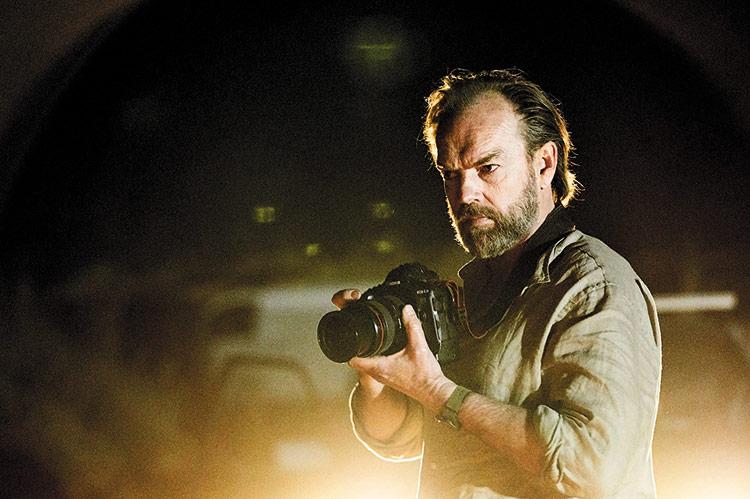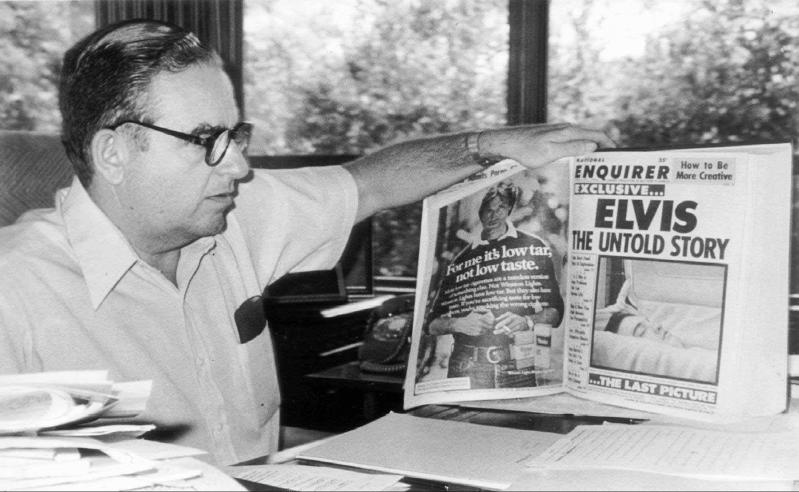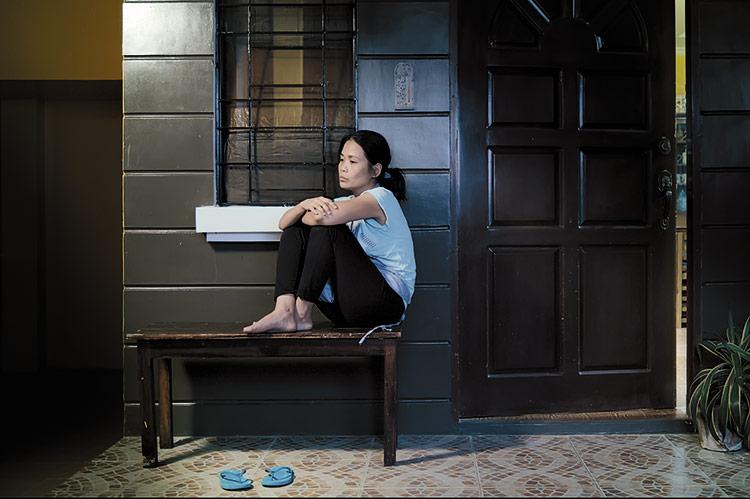The Hamptons International Film Festival, which happens today through Monday, offers scores of films in every category — narrative and documentary, features and shorts, foreign and domestic, and now even virtual reality. Each year The Star’s writers and editors preview a handful of selections for the curious who may want a bit more information before committing to a ticket or a rush line. Jennifer Landes, Mark Segal, Judy D’Mello, and Christopher Walsh considered this year’s selections.
“Scandalous”
Mark Landsman
Southampton Cinema, tomorrow, 7 p.m.
East Hampton Cinema, Sunday, 8:30 p.m.
For decades, The National Enquirer has occupied a place in the hearts and minds of Middle America and a remarkably influential space at checkout lines everywhere.
As a result, even those who don’t read it can’t help but absorb its front-page headlines. For most of its existence, those stories have been about celebrity highs and lows: at home with Bob Hope, on set with “The Cosby Show,” baby bumps, and deaths (Elvis, John Belushi, Princess Di).
But with the Gary Hart scandal in the ’80s and new management beginning in 1999 with David Pecker’s purchase of its holding company, American Media Inc., the paper began a focus on more political coverage, often with a perceived point of view.
This came to full flower in the campaign of President Donald J. Trump, who enjoyed positive coverage while his opponents were accused of being a son of a Kennedy assassin (Ted Cruz) or on death’s door (Hillary Clinton). Mr. Pecker’s relationship with Mr. Trump began prior to his acquisition of A.M.I., when he published “Trump Style” to be distributed at Trump properties. The relationship ended up with Mr. Pecker being subpoenaed and given immunity as a witness for his “catch and kill” methods of locking down the exclusive rights to the stories of women who asserted they had affairs with Mr. Trump and then not publishing the stories.
The film begins with the publication’s origins as the brainchild of Generoso Pope Jr., the son of the successful founder and publisher of Il Progresso, an Italian language newspaper based in New York City. The son purchased The New York Evening Enquirer in 1952, changed the title to The National Enquirer, and began publishing the paper as a tabloid trafficking in scandal and gore.
The film is told through entertaining and informative talking-head interviews with reporters and editors from the past and probing commentary by media watchers such as Carl Bernstein and Ken Auletta, who credit the tabloid, along with its sister and rival publications, as helping foster and normalize “fake news.” J.L.
“Talking About Trees”
Suhaib Gasmelbari
East Hampton Cinema, Friday, 3:15 p.m. and Sunday, 4:15 p.m.
Right away in the opening scene you realize that “Talking About Trees” is something special. Four older Sudanese men, in the midst of one of Khartoum’s frequent power outages, re-enact the scene from “Sunset Boulevard,” in which Gloria Swanson descends the staircase (played by one of the men with a blue scarf draped over his head) to deliver the famous line, “Alright Mr. DeMille, I’m ready for my
close-up.”
This superb documentary by Suhaib Gasmelbari follows the story of a quartet of African filmmakers, who in April 1989 had formed the Sudanese Film Group to give their industry more independence from a restrictive government. But in June of that year, a deadly military coup installed an Islamist-backed regime that virtually eradicated all creative aspirations and society-led organizations such as theirs. By 2005, some restrictions were lifted and the men, who had scattered all over the world, soon after returned to their homeland to re-establish the group and help resurrect the lost art of cinema in Sudan.
With unfaltering artistry, Mr. Gasmelbari captures the essence of what it means to be a cinephile, to have such a love for this art form that it resides in your bones, in your dreams, and daily life. He includes lovely clips of some of their old films, many of which are in a poor state, following years of neglect and inadequate storage in Sudan’s harsh climate.
“Talking About Trees” also reveals a rich history of Sudanese cinema making. Prior to the coup, Sudan was home to more than 60 cinemas, including 16 in Khartoum that often screened films from Hollywood and Bollywood. Today, just three decaying cinemas operate in the capital. But the men are determined to resurrect the once-grand movie house in the center of their city and we follow them as they battle endless bureaucratic hurdles and impenetrable permit requirements. They find humor in the situation, too, noting that long before they will be granted a permit to install a projector, at least two new mosques will have been built.
Cinephiles will surely delight in this documentary as they root for these passionate men fighting to protect their country’s visual memories. J.D.
“The Hottest August”
Brett Story
East Hampton Cinema, tomorrow, 10:30 a.m.
Southampton Arts Center, Monday, 2 p.m.
Brett Story’s “The Hottest August” is a study of civilization on the edge, as depicted in the microcosm of New York City across the month of August 2017, five years after Superstorm Sandy devastated much of the coastline and lower Manhattan.
Each day that month, a stranger asked questions of people on the street, on beaches, in parks, bars, and apartments as the “Capital of the World” swelters.
“The tide,” a narrator intones, “left debris in various formations.” Indeed, Sandy looms large amid laments of gentrification, an ever-expanding gap between rich and poor, and the struggle to escape circumstances or to simply maintain dignity and security in a world upended by the election of Donald Trump and increasingly perturbed by a surge in extreme weather.
Much of “The Hottest Summer” is set in the outer boroughs, blue-collar neighborhoods as well as the densely crowded beaches of Brooklyn and Queens. “I think there’s a much more real fear for us that our kids might not live out their full lives,” says a young woman lounging on the sand. As her words hang in the humid air, Mr. Story’s camera rests on an older woman sitting alone on the sand, gazing vacantly seaward.
Others are less uncertain. “It was a hundred-year storm,” an older woman says, gesturing to her beachfront house, which she says held 13 feet of water during Sandy. “That means there’s not going to be another storm for another hundred years.” Does she not believe in climate change, she is asked. “No, I don’t believe in that. That’s Al Gore. He’s making tons of money on all of that.”
Scenes and sounds of the concrete jungle blur into the hum of transistors or the relentless sunshine, recalling to this viewer the 1983 documentary “Koyaanisqatsi” (the Hopi word meaning “life out of balance”), an arresting depiction of humanity’s separation from, even hostility to, nature.
Thirty-six years on, the fruits of civilization’s relentless trashing of our shared biosphere are most poignantly conveyed by a young man demonstrating a virtual reality game. V.R. goggles masking his face, he battles “red polygon characters,” describing “a game within a game . . . some sort of simulation.”
He follows with a thoughtful discourse on how capitalism’s embrace of automation might, through taxation, fund a guaranteed minimum income, housing, health care, food, and education, a liberating rather than a destructive force.
He shrugs. Suddenly despondent, he adds this postscript. “It might also all be gone in five years.” C.W.

“Hearts and Bones”
Ben Lawrence
Guild Hall, tomorrow, 11:45 a.m.
Southampton Cinema, Saturday, 8 p.m.
In a world riven by violence and displacement, disparate lives can collide with unexpected consequences. Such is the case in the Australian film “Hearts and Bones,” when a chance connection occurs in Sydney between an immigrant taxi driver from South Sudan and an Australian photojournalist.
When Dan (Hugo Weaving), a celebrated war photographer just back from Iraq, is interviewed on a radio program about an upcoming retrospective of his photographs, Sebastian (Andrew Luri), after listening to the interview, tracks Dan down and asks him to photograph his community choir.
Dan at first demurs, explaining he’s not that kind of photographer. But when Sebastian returns to Dan’s house to serenade him with the choir, which is made up of half a dozen men from different African countries, Dan begins to reconsider.
At the same time, when Dan’s longtime companion, Josie (Hayley McElhinney), tells him she is 15 weeks pregnant, he is so stunned and angry that he staggers out of his house and collapses in front of Sebastian, who had been waiting outside.
Sebastian’s interest in Dan takes on a new dimension when we learn that Dan had photographed atrocities in Sebastian’s home village. As their friendship develops, Sebastian asks Dan not to include those images in his exhibition.
Meanwhile, Sebastian’s wife, Anishka (Bolude Watson), who has one child and another on the way, is unaware that Sebastian had a wife and family in South Sudan, all of whom were killed during the conflict there.
“Hearts and Bones” is an intense experience. Both men suffer from PTSD and depression, Dan is torn between Josie’s insistence he show the photographs and Sebastian’s demand that he withhold them, Josie’s pregnancy has imperiled their relationship, and Sebastian is tormented by his deception of Anishka.
The performances are riveting and nuanced, especially that of Mr. Luri, a first-time actor who was driving a garbage truck in Melbourne when he auditioned for the role. Ben Lawrence, the director and co-writer, artfully paces the action and the revelations.
A coda consisting of photographs of refugees fleeing their various countries, accompanied by the Talking Heads’ “Road to Nowhere,” underlines the tragic conditions that have taken their toll on all four characters and their relationships. M.S.
“Overseas”
Sung-a Yoon
East Hampton Cinema, Friday, 10:15 a.m.
Southampton Arts Center, Saturday, 12:45 p.m.
“Never cry in front of your employers,” an instructor yells at a young Filipino woman pretending to sob. “It shows weakness. Filipinos are not weak!”
A harrowing and illuminating piece of vérité from the Korea-born, Brussels-based director and writer Sung-a Yoon, “Overseas” is an unflinching documentary that examines the training of maids in the Philippines to become Overseas Filipino Workers (a.k.a. O.F.W.s). Around 10 million Filipinos, many of whom are maids, are part of a the global work force, sent all over the world into domestic service, often to support their children back home. Twelve percent of the Philippines’ G.D.P., about $30 billion, comes as remittances from nationals working abroad.
The director effectively plays fly on the wall at a training facility, where young women receive rigorous and extensive instruction in what to expect in their new workplaces, which sadly includes every aspect of abuse, including sexual. There’s even a bit of twisted levity as we observe role-plays between the women, who must act out potential hazards, such as how to handle a wicked employer who has becomes jealous that her daughter is spending more time with the kind maid and eating her “dirty” food, rather than with her own family. In another, the women are taught how to set a table, complete with cutlery for several courses, and to learn exactly when to inquire, “Are you finished with your tuna canapé, ma’am? May I bus it out?”
On occasion, the camera leaves the training center and we get a glimpse of the sheer scale of the O.F.W. phenomenon, like in a vast bureaucratic building, filled with hundreds of overseas workers waiting for their paperwork, which is piled high in the corridors. It makes the D.M.V. seem like Disneyland.
“Overseas” is a sympathetic and often heartbreaking depiction of the tough psychological traumas many of these women endure. The Philippine’s President Duterte magnanimously hailed overseas workers as the nation’s heroes and heroines. After watching the film, it is clear these are mere euphemisms for his country’s greatest economic engines. J.D.
“Romantic Comedy”
Elizabeth Sankey
East Hampton Cinema, Friday, 11:15 a.m.
Southampton Arts Center, Sunday, 3:15 p.m.
It is a truth universally acknowledged that a single man in possession of a good fortune must be in want of a wife. Had Jane Austin been around during the 1990s, the golden age of the romantic comedy film genre, she would have surely added this to her famous sentence: And that wife must be white, straight, middle-class, college-educated, beautiful, funny, able to drink like a fish, preferably have a non-white L.G.B.T.Q. best friend, possess fascinating complexity, never be needy, able to talk and play sports, and must basically meet all of men’s unrealistic and damaging fantasies of hetero-normative perfection.
For that, according to the British filmmaker and musician Elizabeth Sankey, is how this loved and loathed film genre has portrayed women from the dawn of the talkies to the present. “Romantic Comedy” is her feature-length documentary debut and it delves deep into the genre’s history and its problematic psychology. Her fascination with the subject began, as it did for many of us, after overindulging in rom-coms of the ’90s that gave us Meg Ryan and Renee Zellweger, and launched a thousand haircuts.
Her unease will surely be shared by many, as she narrates over a fascinating montage of clips from hundreds of romantic comedies through history, forcing us to grapple with our memories of these often saccharine films with bizarre premises, almost always featuring females seeking salvation by men, and all the excuses we made for having loved them. Also featured is a great score composed by the director’s band and intelligent insights from contributors in the media.
Astutely, Ms. Sankey points out the disturbing fact that this genre is dominated by women — on the screen, behind the camera, and in the audience. But, by no means, does she imply that the rom-com genre is over in our new woke state. In fact, she offers a few smart thoughts to ensure a happy and everlasting future.
“Romantic Comedy” is a delightfully thought-provoking movie, best enjoyed while eating a giant tub of popcorn and Milk Duds. J.D.
“Three Summers (Tres Veroes)”
Sandra Kogut
East Hampton Cinema, Sunday, 2:15 p.m.
Southampton Arts Center, Monday, 4:30 p.m.
“Three Summers” begins as a kind of Brazilian “Downton Abbey” whose characters — a wealthy family and their friends, and the household staff that serves them — reflect not only the gulf between rich and poor but, eventually, the resourcefulness that enables the workers to survive and even prosper when their world is turned upside down.
The story takes place over three Christmas holidays at the family’s beachfront vacation home. The director, Sandra Kogut, lets the story meander, at times a bit too leisurely, but her preference for ellipsis over explanation keeps the viewer engaged.
At the center of the story is Mada, the chief housekeeper, in a performance of extraordinary range by the Brazilian actress and comedian Regina Casé. In the film’s first section, set in December 2015, the homeowners, Edgar and Marta, are celebrating their anniversary and the holidays with a boisterous houseful of guests.
Beneath the surface run currents of anxiety for both Mada, who is urging her boss to fulfill his promise to lend her the deposit for a piece of property, and Edgar, whose mood drifts from celebratory to sad to suspiciously preoccupied.
When the action shifts to a year later, Mada is scrambling to deal with the cancellation of the household’s holiday festivities. The pieces gradually fall into place: Edgar has been arrested, agents arrive to search the house, Mada is brought in for questioning, her newly acquired property is seized, and the staff has not been paid.
Unbowed, Mada and her co-workers toast with the champagne originally destined for the family’s Christmas festivities, then embark on a series of initiatives that bring to mind Tony Curtis’s observation from the comedy “Operation Petticoat”: “In confusion there is profit.”
While the last two-thirds of the film focus on the pluck and ingenuity of Mada and her colleagues, one senses that their celebration during the final scene is only temporary. For the arrest of Edgar is situated within the wider context of Operation Car Wash, Brazil’s ongoing bribery and money laundering scandal, which led to the arrest of the progressive president Lula da Silva and the accession of the archconservative Jair Bolsonaro. M.S.
“Museum Town”
Jennifer Trainer
East Hampton Cinema, Sunday, 10 a.m.
“Museum Town” seems at times like the kind of film running in an alcove near an admissions desk. That might be expected, since its director was a founder of the Massachusetts Museum of Contemporary Art (Mass MoCA), and was its head of development at the time of its filming, but it is much more.
Jennifer Trainer, now the director of Hancock Shaker Village in Hancock, Mass., tells an intimate origin story, but it is also a bracing history of the town from which it rose as a rehabilitation of an abandoned factory campus. She does not shy away from the museum’s flawed rollout and failures before it finally took off as an economic force in a classically depressed area.
North Adams, Mass., was a typical New England factory town from its earliest days. Sprague Electric, an electronic component maker, took over the town’s economy in 1926. At its height, it employed most of the North Adams residents, including women, who were hired out of high school during World War II.
Much of this story is personified through the eyes of a museum volunteer, Irene Yarter, who was one of those women and who lost her job when the factory closed in 1985. Her hope and uncertainty functions as a chorus for the townspeople, who watched millions being spent on the museum for years without much to show in terms of rebirth for the town itself.
At the same time, the museum, which offers unparalleled space for artists to experiment and dream big (one building is as large as a football field), has brought in the artist Nick Cave to create a monumental and extravagant installation. The film follows that process from idea to opening, offering a glimpse into the creative minds at work behind the scenes.
Ongoing installations by Jenny Holzer, Laurie Anderson, Joseph Beuys, James Turrell, and many others offer a stunning glimpse into the realized potential envisioned by its founders, including Thomas Krens, who came up with the idea as the director of the Williams College of Art, long before he led the Guggenheim Museum on its own quests. J.L.




